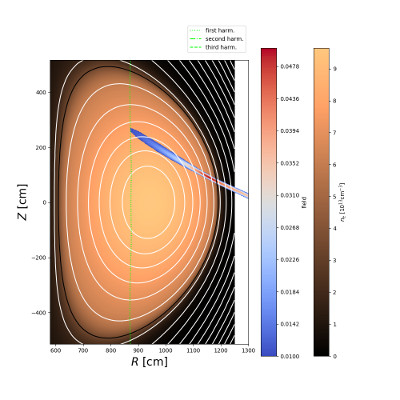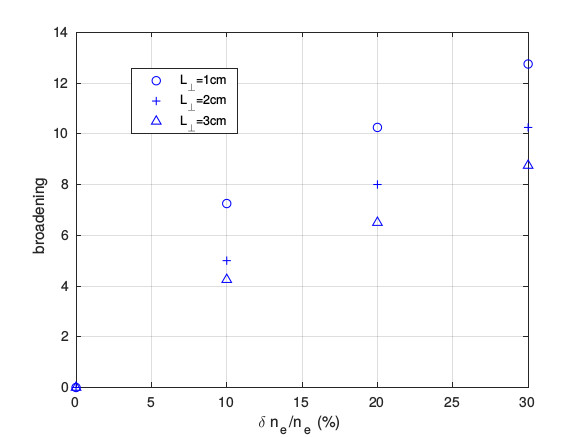Speaker
Description
This contribution presents a numerical assessment of the impact of density fluctuations on the electron cyclotron (EC) wave in view of neoclassical tearing mode control in European DEMO. We show that, using the current design for the EC system launching the EC wave from equatorial outboard plane, the quality of the EC current profile is severely affected by the density fluctuations located at the plasma edge. The EC wave is diffused and has a width roughly 4-12 times wider (depending on the turbulence parameters) than originally designed in the absence of fluctuations. Therefore, control of neoclassical tearing modes within given installed power of EC system might become problematic or even impossible with the allocated EC power. The main reason for the deterioration is shown to be the EC injection geometry - the propagation path from the equatorial outer midplane to the resonance q = 1.5, 2 surfaces is about 2 meters, therefore, the angle deflections imparted by the scattering process in the plasma periphery are amplified by this long propagation distance. A design iteration where the EC beam is launched from upper port is considered, this option is compromised in view of technology (uppor port access is very limited) but might be necessary to restore NTM control.
Neoclassical tearing modes (NTM) severely limit the performance of burning plasmas by providing fast perpendicular transport of heat and particles within the NTM. This will reduce the temperature and drop the fusion yield. Hence, automized real-time control of NTMs have been studied and proven in various experimental machines, e.g. [1, 2]. The control scheme is based on launching EC wave to replace part of the missing bootstrap currrent ultimately driving the NTM. Recently, this process was re-iterated in view of ITER, where the plasma regime is slightly different from the exprerimental machines where NTM control has successfully been demonstrated. It was realized [3] that transport due to density fluctuations might pose a real risk for NTM control. Later on, this was shown by numerical simulations [4]. Further interest in the field has resulted in experimental efforts to show that the transport can not only be calculated using numerical tools but also measured experimentally [5, 6].


This work for European DEMO is a natural extension to the work carried out for ITER [4]. We use the exact same numerical tool, the WKBeam code, and repeat the exercise only us-ing DEMO specific plasma and wave parameters, and geometry [7]. The current EC design of DEMO is based on last steerable mirrors located at the outer equatorial midplane ports, as indicated by Figure 1. The numerical model for the turbulent density fluctuations is the same as used in [4] (interestingly although plasma parameters are different, e.g. the scaling for perpendicular correlation length will result in exact same numbers for ITER and DEMO). Here we present scan over the fluctuation amplitude at the SOL and correlation length in the perpendic ular direction in Figure 2. In this Figure, the broadening of the beam is defined as relative increase of the FWHM of the beam deposition profiles. The values of broadening are of the order of 8, for the best educated guess for turbulence parameters (L_⊥ =2 cm, δ n_e /n_e =20 %). This large broadening is putting severe constraint to the power required to control the NTM. The sensitivity analysis shows that this level of broadening is expected even for different variations of density profiles and turbulence parameters, suggesting that the result is not much dependent on the model input for the fluctuations. In particular, even just 5% fluctuation level would cause broadening by a factor of
4. The fluctuation model indeed is the main uncertainty in the numerical WKBeam model so the obtained result can be considered reliable, although not exact. The reason for such high broadening of the beam is identified to be the large propagation length between the turbulence layer located at the density pedestal and the resonance surface where the narrow beam width is necessary to drive the current within the NTM. Indeed, in current DEMO design, this distance is roughly 2m while in ITER it is only 50cm.
We are currently assessing quantitatively the advantages of launching the beam from upper port as done for ITER. This will consirerably reduce the propagation path. However, such option is technologically more challenging to realize and needs strong evidence of performance improvement before it will be considered. Moreover, we are carrying out a study to estimate the necessary amount of EC power necessary to control NTMs as was done in [3].
References
1 E. Kolemen et al., Nucl. Fusion 54, (2014)
2 F. Felici et al., Nucl. Fusion 52, (2012)
3 E. Poli et al., Nucl. Fusion 55, (2015)
4 A. Snicker et al., Nucl. Fusion 58, (2018)
5 O. Chellai el al., Phys. Rev. Lett. 120, (2018)
6 M. Brookman et al., EPJ Web of Conferences 147, (2017)
7 T. Franke et al., submitted to Fus. Eng. Des., ISFNT, (2019)
| Affiliation | Aalto University |
|---|---|
| Country or International Organization | Finland |
